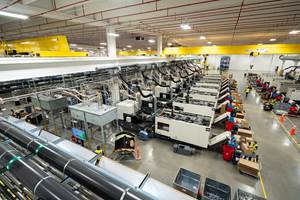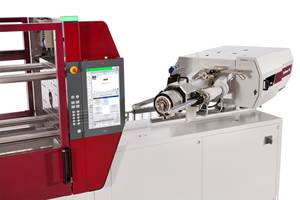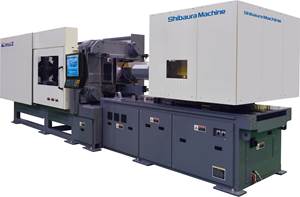Dual Gas-Assist Techniques Advance Large-Part Molding
A novel combination of internal and external gas assist is the secret to injection molding a large panel that is both structural and requires a highly cosmetic surface.
A novel combination of internal and external gas assist is the secret to injection molding a large panel that is both structural and requires a highly cosmetic surface. The process was developed by Mack Molding, headquartered in Arlington, Vt., a major custom molder and contract manufacturer, which had plenty of previous experience with both internal and external gas molding but none with the processes combined in one application.
“To the best of our knowledge, this is the first time internal and external gas assist have been used together to mold a large structural part with a Class A surface. We believe this to be an industry first and a trend-setter for large injection molded parts,” says Brian Sumpter, business development director at Mack’s Inman, S.C., facility, where this product is made.
“This technique can open up the market for both cosmetic and functional injection molded parts,” Sumpter adds. He says structural cosmetic applications in the truck market have been dominated by painted RIM, SMC, or thermoformed parts. Up to now, injection molding was considered too expensive for the fairly small production volumes (5000 to 20,000 pieces), due to high tooling costs and difficulties in maintaining surface quality in large parts.
Mack Molding developed its dual gas-assist process to mold the base of an external refrigeration unit for semi-trailer trucks. The part measures roughly 76 in. long x 22.4 in. wide x 0.180 in. thick. The 15.3-lb part, commercialized this spring, sits between the truck cab and front of the trailer. It was previously produced by twin-sheet thermoforming of ABS/PC with high gloss on one of the two sheets.
The customer, a major producer of temperature and climate controls for the transportation industry, came to Mack Molding because the thermoformed parts experienced a high failure rate in the field. “This was due mainly to impact failures and cracking from abuse during maintenance of the refrigeration unit,” says Ken Kincaid, technical engineering manager of Mack’s Southern Div. at Inman. The customer also wanted to obtain a highly cosmetic part right out of the mold that would be comparable to a painted panel. That presented difficulties for conventional injection molding, considering the sheer size of the part and the presence of structural ribs and bosses. Preventing sink marks and holding down the cycle time would be a challenge.
Gas inside and out
Mack’s solution was two-step nitrogen gas injection during a single cycle. Mack starts by injecting a full shot of resin into the tool. After a 25-sec delay, internal gas is injected to core out bosses and the 2.5-in.-thick rim around the part. The internal gas displaces material and creates a gas channel of 1.6 in. diam. around the rim. The internal gas holds the rim of the part against the mold surface to aid cooling, and enables the rim to seal off the periphery of the part, which assists the external gas step. The external gas is applied on the core side, between the mold and part surfaces, to pack out the part and ensure a good surface on the cavity side. “The external gas provides a good surface and reduced stress on the part,” says Sumpter.
Separate distinct gas pins are used for internal and external gas injection, but both are located on the core side of the mold. Mack is licensed by Gain Technologies to use the internal and external gas process. Mack also holds a mold-specific license from Cinpres for external gas assist. Mack uses a single gas-control system from Alliance Gas Systems (now part of Cinpres).
Gains with gas
Gas assist produced large savings in tool costs, says Sumpter. Conventional injection would have required a multi-drop hot-runner system and sequential valve gating to keep manageable flow lengths in such a big part. Because the gas helps push the resin to pack out the mold, Sumpter says the process needs just one drop. Also, the part design would have required tooling movements, such as a lifter and slide system, which would have added at least $30,000 to the tool cost.
Mack calculated that the 1700 sq in. projected area of the part and typical clamping requirements of 3 tons/sq in. would have demanded a press of at least 5000 tons. But with gas assist, Mack is molding the part on a 3000-ton press.
Material savings result from the material displaced by the gas, and Mack was also able to use a less expensive resin, Geloy ASA from GE Plastics to maintain the necessary structural and cosmetic properties. The resin is inherently weatherable without paint, and the external gas helps provide a 90 gloss rating right out of the mold.
Related Content
50 Years...600 Issues...and Still Counting
Matt Naitove marks his first half-century in plastics reporting, with a few of his favorite headlines.
Read MoreIPEX Opens Injection Molding Facility in North Carolina
The pipe and fittings manufacturer’s new 200,000-square-foot facility represents a $200 million investment and will create 150 jobs.
Read MoreFakuma 2023: More Details on New Machine Line
Wittmann Battenfeld has released more details on the new EcoPower B8X debuting at Fakuma (October 17-21; Friedrichshafen, Germany), which it previously announced.
Read MoreCompletely Connected Molding
NPE2024: Medical, inmold labeling, core-back molding and Industry 4.0 technologies on display at Shibaura’s booth.
Read MoreRead Next
Why (and What) You Need to Dry
Other than polyolefins, almost every other polymer exhibits some level of polarity and therefore can absorb a certain amount of moisture from the atmosphere. Here’s a look at some of these materials, and what needs to be done to dry them.
Read MoreAdvanced Recycling: Beyond Pyrolysis
Consumer-product brand owners increasingly see advanced chemical recycling as a necessary complement to mechanical recycling if they are to meet ambitious goals for a circular economy in the next decade. Dozens of technology providers are developing new technologies to overcome the limitations of existing pyrolysis methods and to commercialize various alternative approaches to chemical recycling of plastics.
Read MoreLead the Conversation, Change the Conversation
Coverage of single-use plastics can be both misleading and demoralizing. Here are 10 tips for changing the perception of the plastics industry at your company and in your community.
Read More

























